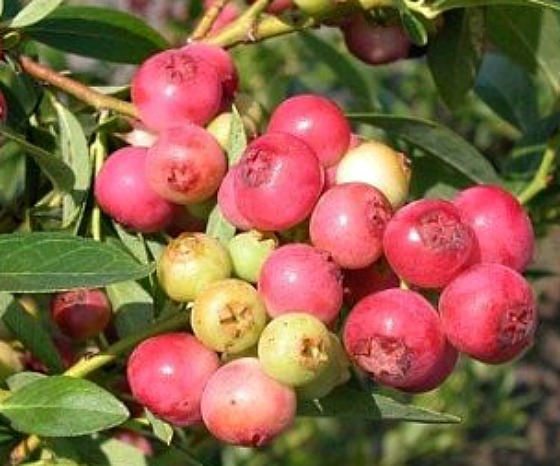Edible landscape plants have become one of the hottest things in gardening. We are seeing a real trend with homeowners who are moving away from the traditional ornamental landscaping and opting for plants that provide food as well as beauty. Blueberry bushes, with their antioxidant-rich berries and spectacular fall foliage, are becoming one of the most sought after plants in residential landscapes today.
Until the 20th century, blueberries could only be found in the wild. They first became available commercially in 1916 and have since then become readily available for anyone who wants to grow them. Blueberry bushes can be purchased bare root or already potted up from garden centers, big box stores, or online retailers. If your blueberry bush is bare root, it’s a good idea to soak it for about an hour prior to planting.

The first step in planting blueberries is to choose your location. Blueberries require full sun. They will not produce fruit unless they are receiving six to eight hours of sunshine each day.
Blueberries thrive in acidic soil and they are happiest in sandy- loamy soil. If you have clay soil, you can build a raised bed or you can plant in pots and containers.
Planting blueberry bushes in containers is a great way to control the pH of the soil. Acidic soil is important to the fruit production of your blueberry bush. What good is a blueberry bush that doesn’t produce berries? Adding elemental sulfur is one way to make your soil more acidic. It can be found at most gardening centers in pellet form. Just mix it into your soil. Sulfur is not water soluble so there is no need to worry about the rain washing it away. (An added bonus: If you have pets, sulfur helps repel fleas from your yard.) If your soil was not very acidic to begin with, a top dressing of sulfur around your blueberry bush every couple years will help it greatly.
You can also work some shredded oak leaves or pine needles into your soil to help lower the pH. Aged saw dust, coffee grounds, vinegar/water solution and “rhododendron food” make good fertilizers.
Choosing you Blueberry Plant
In the wild, blueberry bushes thrive in the northeastern corner of the United States and upward into Canada. All blueberries require a certain number of hours where the temperature falls between 33-45 degrees Fahrenheit or they will not produce berries the following season. Blueberries have since been cultivated to grow in a much wider variety of climates based on their chilling requirements.
Here are the different types and what they mean to you:
Low Bush Blueberries
Low bush blueberries were the most commonly found wild variety. They have the longest chilling requirements and can usually be grown in zones 3-7. They are creeping plants that grow about a foot or so high. They should be planted about 2 feet apart and cut to the ground every 2-3 years. They will not produce fruit the year after cutting (so plan ahead if you want a continuous supply of berries). Low bush blueberries are commonly found canned and packaged at the supermarket. The berries tend to be a bit smaller than other varieties, but are very sweet.
High Bush Blueberries
High bush blueberries are the most common “garden” varieties. Northern high bush varieties grow in zones 4-7 and Southern high bush varieties grow in zones 5-9. Southern high bush varieties tend to have smaller berries than the Northern high bush varieties, but they are much more heat tolerant. High bush blueberry plants grow to an average height of 6-8 feet and will sometimes grow to 12 feet. When planting, space them 3-4 feet apart. The stems become unproductive after 6 years and should be pruned off.
Half- High Blueberries
Half-highs are a cross between high bush and low bush. They grow in zones 3-7 and reach a height of 2-4 ft.
Rabbit Eye Blueberries
Rabbit eye blueberries get their name because the berry turns a pink shade (like a rabbit’s eye) before ripening to blue. Rabbit eye are low chill varieties suited for zones 7-9. They can be grown in colder zones, but because of their low chilling requirements they are apt to produce berries early which could result in losing a crop to spring frost. Rabbit eye blueberries are more tolerable of drought and poor soil conditions than the other varieties. Surprising to most people, they are actually taller than the high bush varieties and if left alone, can reach heights of 20 feet.
You will also find that blueberry plants are categorized by season. This gives us a general idea of when to expect berries.
- Early Season (June)
- Mid-Season (July)
- Late Season (August)
When planting blueberry bushes, it is often helpful to add some peat moss to the hole before placing your blueberry plant. This helps with drainage and adds a little acidic boost.
Blueberry plants have shallow root systems. They like a good supply of water (1-2 inches per week) but it should drain well because they hate wet feet. The soil should be moist, but well drained. Blueberry leaves are a bit on the leathery side and they don’t appear to dry out when your plant is thirsty. You are more likely to notice branches drying out.
Your plant should require little to no pruning for the first 3 years. Then you may begin pruning to shape or control your plant. (Low bush varieties that need to be cut back every 2-3 years are the exception, of course).
Young plants may begin to fruit, but a blueberry bush will not be fully productive until it is 6-8 years old. Pinch off all flowers until your plant is 2 1/2 feet high because allowing fruit will slow the growth of your blueberry bush.
Mature plants that are “over flowering” tend to produce smaller berries. Pinch off some flowers for larger fruit. Most blueberry bushes will continue to produce fruit for about 20 years.
Ripe blueberries are fully blue. Once they are blue wait a couple days before picking them. They will fill with water and swell about 35% larger. Give the branch a gentle shake. Only the ripe berries will fall into your hand.
Mike McGroarty is the owner of McGroarty Enterprises and the author of several books. You can visit his website at Freeplants.com and read his blog at MikesBackyardNursery.com.
Related Articles & Free Email Newsletter Sign Up
How and When to Cut Back Ornamental Grass
How to Make Sprinklers on Standpipes




Comment here